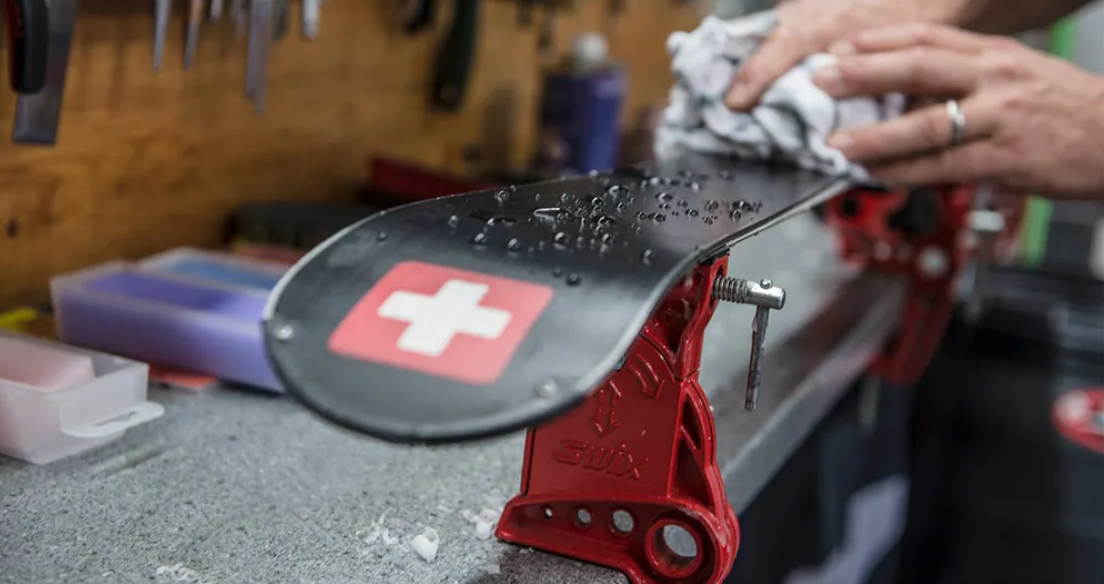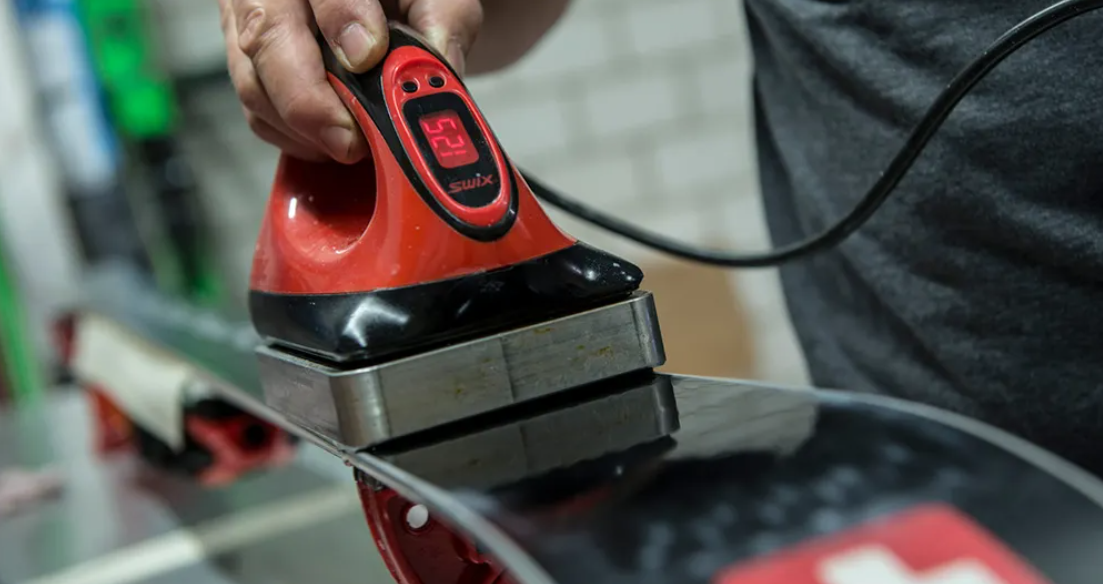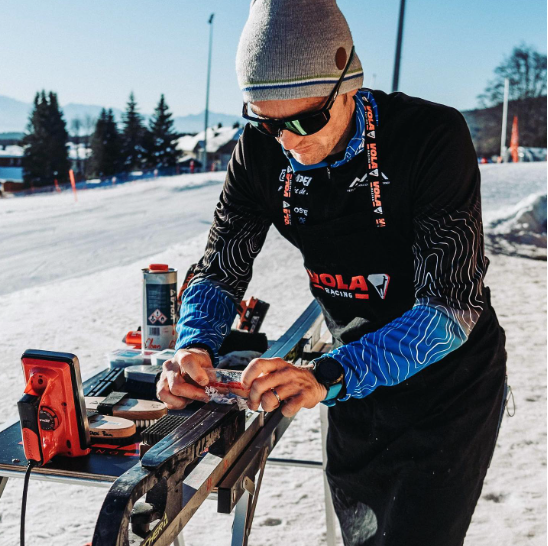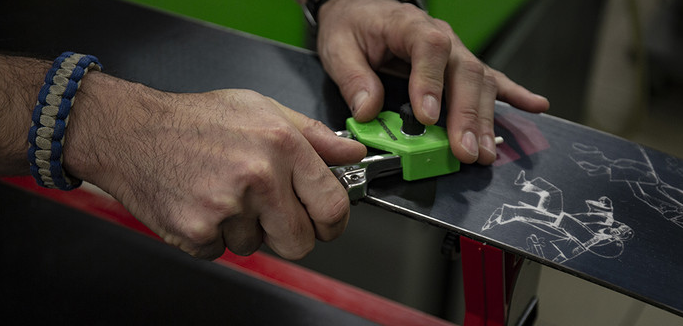WHY SHOULD I REGULARLY MAINTAIN MY SKIS AND SNOWBOARD?
To find out why you need to maintain your skis and snowboards regularly, you need to know how they're made. They are generally made up of a slat, bindings and edges, all of which require special attention.
The slat, which forms the core of the ski/snowboard, can be made of injected foam or wood. Foam skis, called monocoques, are more economical, absorb vibrations and are commonly used in entry-level models. However, they have a limited lifespan and wear out more quickly in the presence of humidity. Wooden skis/snowboards, while stronger, require a more expensive manufacturing process. Both types of core require regular waxing to prevent moisture infiltration.
Last but not least, the metal edges along the ski/snowboard grip the snow for better handling in turns. It's important to sharpen them regularly, although the frequency depends on use. Testing the edges by running your fingernail over them is one way of determining whether they need sharpening, thus avoiding excessive sharpening that could reduce the equipment's lifespan.
Maintaining your equipment on a regular basis is of paramount importance to guarantee optimum performance, whatever the snow conditions. Well-maintained skis are the key to excellent edge grip and smooth gliding, which are essential to improving your level and maximizing your pleasure on the slopes!
.png)
HOW TO CARE FOR YOUR SKIS AND SNOWBOARD BEFORE THE SEASON?
Ski/snowboard maintenance starts well before the season, so it's important to prepare your skis and snowboards well before the season. You'll need to check the condition of your base and edges to see what work needs to be done, then you have two options. You can take your equipment to a store for maintenance, or you can do the maintenance yourself. Caring for your skis at home is much more economical and takes almost as much time as taking them to the store, so we're going to teach you how to do it yourself!
STEP 1 - CLEAN YOUR SOLES
Now that all residues and impurities have been removed, your ski/snowboard is ready to be waxed.
STEP 2 - MELT AND SPREAD WAX
STEP 3 - SCRAPING AND BRUSHING THE BASE
STEP 4 - EDGE SHARPENING
How to choose sharpening angles?
Edge grinders offer a wide range of angles, often between 85° and 90°.
For beginners, occasional skiers or freeriders, we recommend a 90° angle.
For competitors, we recommend an angle of 88° or less.
HOW TO LOOK AFTER YOUR SKIS DURING THE SEASON?
When you're out and about on trails strewn with pebbles and tufts of grass in springtime, you may notice holes, scratches and even scuffs on the soles of your skis and snowboards. Wax plays a dual role as a protective layer and as an aid to gliding over the snow. It's essential to fill in these scratches regularly during the season by applying a new layer of wax to avoid any wet contact with the ski core.
WHICH TYPE OF WAX TO CHOOSE?
There are two types of wax: solid and liquid. Solid wax comes in the form of a loaf to be melted and spread on the base. This type of wax requires more equipment and know-how, but is essential for good ski maintenance and longevity.
Liquid wax, on the other hand, is much easier to use, and is recommended for beginners wishing to maintain their skis. It's an extra wax that can be applied mid-season to fill in a few scratches.WHICH TYPE OF WAX FOR WHICH CONDITION?
There are different types of wax, each for a different type of snow. Choosing the right type of wax for the right type of snow ensures optimum glide. To find out which type of wax is best suited to which conditions, manufacturers have agreed to use a standardized color code.
WHITE or COLORLESS Wax: This is a universal wax that can be used in all conditions, but will not be as effective as a temperature-specific wax.
FART ROUGE: The fine weather is starting to arrive, but the snow remains as good as ever. It's the end of February and time to use red wax, for conditions between -4°c and +4°c.
JAUNE FART: That's it, it's spring! The end of the season is upon us, and it's time to make the most of the last runs on snow that's often very wet. That's when you need yellow wax for conditions between 0°c and +10°c.
.png) |
HOW TO LOOK AFTER YOUR SKIS AFTER THE SEASON?
STEP 1 - WAXING
It's best to wax your equipment before storing it. To avoid having to do the job several times, use a cold-snow wax (blue or purple) or a universal wax. Proceed in the same way as for waxing skis at the start of the season. We advise you to use the overmolding technique, i.e. to protect the base by applying a generous layer of extra wax and let it dry. Once dry, you can store your skis all summer long, and all you have to do is scrape off the excess at the start of the season, and your skis will be as good as new!
STEP 2 - DRYING THE EDGES
Edges are an important part of ski and snowboard performance, and it's important to take good care of them to ensure the best possible longevity. Edges are made of metal, and like all metals, they are sensitive to rust. So it's important to dry them thoroughly with a soft cloth. And be sure to store your skis in a dry place.
STEP 3 - HOW TO STORE YOUR SKIS?
As mentioned above, it's important to store your skis in a dry place. It's also advisable not to glue the tips together, as this could lead to condensation and humidity.
There you have it: all you need to know to look after your skis. All these tips and best practices will help you give your skis the longest possible life. Now all you have to do is enjoy the snow, the sun and the raclettes!
 |


























